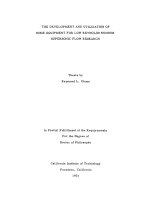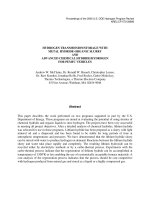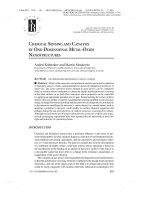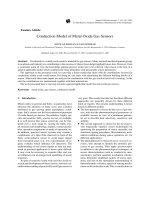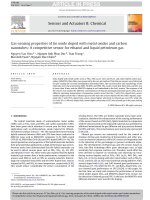- Trang chủ >>
- Khoa Học Tự Nhiên >>
- Vật lý
hybrid metal oxide and multiwall carbon nanotube films for low temperature gas sensing
Bạn đang xem bản rút gọn của tài liệu. Xem và tải ngay bản đầy đủ của tài liệu tại đây (708.05 KB, 6 trang )
Sensors and Actuators B 127 (2007) 137–142
Hybrid metal oxide and multiwall carbon nanotube
films for low temperature gas sensing
E.H. Espinosa
a
, R. Ionescu
a
, B. Chambon
b
, G. Bedis
b
, E. Sotter
a
,
C. Bittencourt
c
, A. Felten
c
, J J. Pireaux
c
, X. Correig
a
, E. Llobet
a,∗
a
MINOS, Universitat Rovira i Virgili, ETSE-DEEEA, Av. Pa¨ısos Catalans 26, E-43007 Tarragona, Spain
b
Institut Universitaire de Technologie GEII Bordeaux 1, 15 rue Naudet, 33175 Gradignan Cedex, France
c
LISE, Falcult ´es Universitaires Notre Dame de la Paix, 61 rue de Bruxelles, B-5000 Namur, Belgium
Available online 8 August 2007
Abstract
Active layers for detecting NO
2
have been obtained by adding a low amount of oxygen-functionalized MWCNTs to three different types of metal
oxides (SnO
2
,WO
3
or TiO
2
). We show that the responsiveness towards NO
2
of micro-sensors based on some of the resulting metal oxide/MWCNT
hybrid films is considerably improved. In particular, the sensors based on hybrid SnO
2
/MWCNTs films present excellent sensitivity towards NO
2
when operated at room temperature. Additionally, the sensors show a total recovery of their baseline resistance and reasonable response and
recovery times. A mechanism of response based on the development of two depletion layers, one at the surface of metal oxide grains and another
at the interface of the n-metal oxide/p-MWCNT hetero-structure, is postulated as responsible for the improvement observed. Our results suggest
that there should be an optimum amount of carbon nanotubes to be added to each specific metal oxide in order to enhance sensitivity.
© 2007 Elsevier B.V. All rights reserved.
Keywords: Gas sensors; Hybrid metal oxides/MWCNTs; Low temperature operation
1. Introduction
Metal oxides are well-known materials suitable for detecting
a wide spectrum of gases with enough sensitivity. These mate-
rials are typically operated at temperatures that range between
200 and 800
◦
C [1–5]. When the detection of toxic species is
devised, metal oxide sensors work usually as surface conductiv-
ity devices. Ambient oxygen is adsorbed at oxygen vacancies
and abstracts electrons via the conduction band. When the
equilibrium concentration of oxygen adsorbates at the surface
of metal oxides is altered by the presence of either reducing
of oxidizing species, the material’s conductivity dramatically
changes. When metal oxide sensors are operated at high tem-
peratures, changes in the microstructure of the gas sensitive film
are likely to occur (i.e., structural changes or coalescence [6]). At
higher temperatures, the mobility of oxygen vacancies becomes
appreciable and the mechanism of conduction becomes mixed
ionic–electronic. The diffusion of oxygen vacancies is known
∗
Corresponding author. Tel.: +34 977558502; fax: +34 977559605.
E-mail address: (E. Llobet).
to be a mechanism responsible for long-term drift in metal
oxide gas sensors [7,8]. Therefore, a strategy to avoid long-term
changes in their response could consist in operating the sen-
sors at temperatures low enough so that appreciable structural
variation never occurs, provided that gas reactions occur at a
reasonable rate.
Additionally, the development of sensors that work at room
temperature would help in developing new applications where
power supply is an issue (e.g. micro-labs with gas sensing capa-
bilities).
Recently, hybrid films based on tin or tungsten oxide and
carbon nanotubes have been introduced as new gas sensitive
materials with improved sensitivity [9–12]. These works indi-
cate that the detection at ambient temperature of toxic gases
such as nitrogen dioxide, carbon monoxide and ammonia or
ethanol vapors can be highlyimproved by dispersingan adequate
quantity of carbon nanotubes into a metal oxide matrix.
In this paper, we study and compare the performance in gas
sensing ofhybrid materials consisting of O
2
-functionalized mul-
tiwall carbon nanotubes (MWCNTs) dispersed in a metal oxide
matrix. Three different metal oxides namely SnO
2
,WO
3
and
TiO
2
were considered.
0925-4005/$ – see front matter © 2007 Elsevier B.V. All rights reserved.
doi:10.1016/j.snb.2007.07.108
138 E.H. Espinosa et al. / Sensors and Actuators B 127 (2007) 137–142
2. Experimental
2.1. Carbon nanotube functionalization
The MWCNTs used were obtained from Nanocyl, S.A. [13].
They were grown by chemical vapor deposition (CVD), had
purity higher than 95%, were up to 50 m in length and their
outer and inner diameters ranged from 15 to 3 nm and 7 to 2 nm,
respectively.
A uniform functionalization with oxygen was applied to the
as-provided carbon nanotubes in order to improve their disper-
sion and surface reactivity. For this activation step the MWCNTs
were placed inside a glass vessel and a magnet, externally con-
trolled from the plasma chamber, was used to stir the nanotube
powder during the plasma treatment.Inductively coupled plasma
at a RF frequency of 13.56 MHz was used during the process
[14]. Once the MWCNT powder was placed inside the plasma
glow discharge, the treatment was performed at a pressure of
0.1 Torr, using two different powers 30 and 100 W, while the
processing time was adjusted to 10 min. A controlled flow of
oxygen was introduced inside the chamber.
2.2. Active layers
The sensing layers were prepared using commercially avail-
able SnO
2
and WO
3
nanopowders (Sigma–Aldrich). On the
other hand, TiO
2
was prepared from alkoxide precursors via
a sol–gel route in dry nitrogen atmosphere. The precursors used
were titanium isopropoxide(IV) Ti[OCH(CH
3
)
2
]
3
with 99.99%
purity [15]. Hybrid materials were obtained by adding 0.7 mg
of oxygen-functionalized MWCNTs to 350 mg of metal oxide
(which gave a proportion of 1/500 wt.%). An adequate mix-
ture of the two components was obtained by dissolving them in
glycerol (employed as organic vehicle) and stirring the resulted
solution in an ultrasonic bath at 75
◦
C for 2 h. The amount of
nanotubes to be added to the metal oxide matrix was based on a
previous study [9]. The pastes thus obtained were subsequently
dropped onto the electrode area of micro-hotplate transducers
[16] (fabricated at the Centre Nacional de Microelectr
`
onica,
Barcelona, Spain) using a microinjector (JBE1113 Dispenser,
I&J FISNAR Inc., USA).
The as-deposited sensing films were dried at 170
◦
C for 1 h
in order to burn out the organic vehicle and after that annealed in
situ at 400
◦
C for 2 h in ambient atmosphere. During the anneal-
ing process, the temperature was raised from ambient to 400
◦
C
using a ramp of 1 h.
In total, six different types of active layers were produced:
• Sample A: SnO
2
/MWCNTs type 1
• Sample B: SnO
2
/MWCNTs type 2
• Sample C: WO
3
/MWCNTs type 1
• Sample D: WO
3
/MWCNTs type 2
• Sample E: TiO
2
/MWCNTs type 1
• Sample F: TiO
2
/MWCNTs type 2
where MWCNTs type 1 and type 2 were functionalized in an
oxygen plasma of 30 and 100 W, respectively.
2.3. Material characterization
The morphology of the hybrid films deposited onto the
micro-hotplate substrates was investigated by scanning elec-
tron microscopy.SEM measurements were performed using Joel
JSM 6400 equipment, with a resolution of 0.3 nm. The magnifi-
cation during thisstudy was set to values varying between30,000
and 150,000. A 30 kV accelerating voltage was employed. The
system allows for sample rotation (360
◦
) and sample inclination
(90
◦
).
2.4. Gas sensing measurements
The gas sensing properties of the different sensing films were
tested in the presence of NO
2
and CO both at ambient tem-
perature and 150
◦
C. Three concentrations of each gas under
study were measured: 100, 200 and 500 ppb for NO
2
; and 1, 10
and 50 ppm for CO. The sensors were placed inside an airtight
5.3 dm
3
measurement chamber and the desired concentrations
of the gases were introduced by the direct injection method.
3. Results and discussion
3.1. Morphological characterization
SEM analyses were recorded in order to observe the mor-
phology of the active films deposited. Fig. 1 shows SEM images
recorded on the different hybrid films studied. These micro-
graphs show the presence of metal oxide grains. The surfaces of
the different films prepared had the appearance shown in Fig. 1,
where carbon nanotubes are not revealed. However, regardless
the metal oxide employed, carbon nanotubes could be observed
in a few regions of the films’ surface (see Fig. 2). Therefore, car-
bon nanotubes are still present in the films after the deposition
process and annealing at 400
◦
C in air. It is due to the low propor-
tion of carbon nanotubes dispersed in the active layers (1/500 in
wt.%) that most of the nanotubes are actually embedded within
the metal oxide matrix.
3.2. Gas response analysis
The measurement process was as follows: data acquisition
started 5 min before injecting into the measurement chamber,
by means of a gas chromatography syringe, the required vol-
ume corresponding to the lowest concentration of the gas to be
measured. Fifteen minutes later (meanwhile the steady state of
the sensor response had been reached), a new amount of the
same gas was injected, so the next concentration of this gas was
reached. The same procedure was repeated until all desired con-
centrations of the different gases under study were measured.
After a series of continuous injection measurements was com-
pleted, air was used to flush the measurement chamber for 1 h,
while the sensors were heated at 150
◦
C to speed up gas des-
orption. Finally, the airflow was interrupted and all sensors fully
recovered their baseline resistance in less than 2 h.
For assessing the gas sensing properties of the different sen-
sors fabricated, sensor responsiveness (S) was defined as the
E.H. Espinosa et al. / Sensors and Actuators B 127 (2007) 137–142 139
Fig. 1. SEM images ofthe different hybrid films fabricated: (a)SnO
2
/MWCNTs;
(b) WO
3
/MWCNTs; (c) TiO
2
/MWCNTs.
Fig. 2. SEM image of a particular region of a TiO
2
/MWCNT hybrid film, where
carbon nanotubes are found laying inside the metal oxide matrix. Similar images
could be recorded for SnO
2
and WO
3
-based films.
ratio between the changes experienced by the sensor resistance
after its exposure to a test gas and the sensor baseline resistance
in air:
S =
R
air
− R
gas
R
air
(1)
where R
air
is the sensor resistance in air and R
gas
is the sensor
resistance in the presence of the pollutant after reaching a steady
state. Responsiveness results are summarized in Fig. 3.
In order to further evaluate the performance in gas sensing
for the different hybrid materials investigated, the sensitivity
defined as the ratio between the changes in responsiveness over
the change in gas concentration was calculated as follows:
Sen|
C
=
S|
C
1
− S|
C
2
C
1
− C
2
(2)
whereS|
C
i
is the sensor responsiveness after the injection of a
concentration C
i
of a toxic gas (as defined in Eq. (1)), C
1
and C
2
correspond to 500 and 100 ppb (case of NO
2
) or 50 and 1 ppm
(case of CO). Table 1 shows the sensitivities of the different
sensors studied when operated at room temperature (25
◦
C) and
at 150
◦
C.
Sensors based on SnO
2
and carbon nanotubes (samples A
and B) were the most sensitive to NO
2
among the different
materials studied. They were able to detect as low as 100 ppb
Table 1
Sensitivities of the different sensors studied as calculated from Eq. (2)
Sample type NO
2
,25
◦
CNO
2
, 150
◦
C CO, 25
◦
C CO, 150
◦
C
A 0.39 0.40 0.01 0.10
B 0.51 0.15 0.01 0.09
C 0.00 0.02 0.00 0.12
D 0.02 0.05 0.00 0.14
E 0.00 0.00 0.00 0.00
F 0.00 0.00 0.00 0.00
C
1
is 500 ppb (NO
2
) or 50 ppm (CO); C
2
is 100 ppb (NO
2
) or 1 ppm (CO).
140 E.H. Espinosa et al. / Sensors and Actuators B 127 (2007) 137–142
Fig. 3. Sensor responsiveness: (a) NO
2
detection at room temperature; (b) NO
2
detection at 150
◦
C; (c) CO detection at 150
◦
C.
of this pollutant gas with responsiveness near 120 even when
operated at room temperature. A similar responsiveness value
was obtained when the sensors were operated at 150
◦
C. Actu-
ally, Table 1 shows that sensitivity is higher when these sensors
are operated at room temperature. For these sensors, the power
used during the functionalization of MWCNTs does not seem
to play a determinant role in their responsiveness to NO
2
. This
is not the case for sensors based on the other two metal oxides
considered, since those employing MWCNTs functionalized at
100 W showed higher responses. A typical response of a SnO
2
and MWCNT sensor to successive concentrations of NO
2
can
be observed in Fig. 4.
Sensors based on WO
3
and carbon nanotubes (samples C
and D) showed some responsiveness towards NO
2
. Operated
at room temperature, their responsiveness reached a value of
0.8 after the injection of 100 ppb of NO
2
, and this value rose
to nearly 10 in the presence of 500 ppb of NO
2
. These val-
ues, although significantly lower than the ones for tin oxide
and carbon nanotube-based sensors, compare favorably to
those previously published for WO
3
and MWCNT hybrid sen-
sors [9].In[9] a responsiveness of 0.02 towards 500 ppb of
NO
2
was reported for 1/100 wt.% MWCNT/WO
3
sensors and
1/1000 wt.% MWCNT/WO
3
sensors were irresponsive to NO
2
.
Therefore, sensor responsiveness heavily depends onthe amount
of MWCNTs dispersed on the metal oxide matrix.
Sensors based on TiO
2
and carbon nanotubes (samples E
and F) showed the lowest responsiveness to NO
2
. Responsive-
ness did not exceed 0.1 after being exposed to the highest NO
2
concentration tested (i.e., 500 ppb).
When CO was measured, similar results were obtained
when either SnO
2
or WO
3
was employed as metal oxide
in the hybrid films (see Fig. 3). Responsiveness peaked at
6.8 for MWCNT/WO
3
operated at 150
◦
C in the presence
of CO 50 ppm. This compares favorably with the previously
reported responsiveness towards 50 ppm of CO (i.e., 0.4) for
MWCNT/WO
3
hybrid films [9]. Table 1 shows that the sensi-
tivity towards CO of tungsten oxide hybrid films is higher than
the one of tinoxide hybrid films. All sensors were irresponsive to
CO when operated at room temperature and TiO
2
-based sensors
were irresponsive to CO even at 150
◦
C.
Fig. 4. Response of a sensor type B operated at room temperature after exposure
to increasing concentrations of NO
2
and recovery in air.
E.H. Espinosa et al. / Sensors and Actuators B 127 (2007) 137–142 141
One important aspect of operating the sensors at 150
◦
C
was their faster recovery of the baseline after gas expo-
sure. For instance, the recovery time of SnO
2
/MWCNTs-
based sensors was reduced from 45 min when operated at
room temperature down to 20 min, while in the case of
WO
3
/MWCNTs sensors,recovery time was reducedfrom 120 to
45 min.
3.3. Discussion
In a previous paper [9] we investigated the responsiveness of
pure WO
3
sensors operated at room temperature. These sensors
were found to be insensitive to NO
2
, CO and NH
3
at low temper-
atures of operation. Additionally, Sberveglieri and co-workers
[17] reported that, thick film TiO
2
-based sensors obtained via
a sol–gel route (equivalent to the one employed in this paper)
were irresponsive to gases when operated at temperatures below
350
◦
C. Finally, it is well known that pure SnO
2
-based sensors
are almost insensitive to gases when operated at room tempera-
ture [10,18].
On the other hand, sensors based on pure MWCNTs (these
nanotubes had been functionalized in an oxygen plasma)
were found to be sensitive to NO
2
when operated at room
temperature [19]. However, the responsiveness reported for
these pure MWCNTs sensors to NO
2
was far lower than
the one reported here for SnO
2
/MWCNT and WO
3
/MWCNT
sensors.
On the basis of the images of the hybrid films recorded
by SEM analysis shown in Fig. 2, it can be derived that
MWCNTs are embedded within the metal oxide matrix.
Since SnO
2
or WO
3
films behave as n-type semiconductors
and oxygen-functionalized MWCNTs films behave as p-type
semiconductors [19], the hetero-structure n-SnO
2
/p-MWCNTs
(n-WO
3
/p-MWCNTs) are formed at the interface between
tin oxide (tungsten oxide) and carbon nanotubes. The exis-
tence of such a hetero-structure has been suggested earlier
for SnO
2
/MWCNT films [10,11]. In hybrid films, two differ-
ent depletion layers (and associated potential barriers) co-exist
[10,11]. The first type of depletion layers is located at the
surface of the grains of the metal oxide film and the second
type at the interface between MWCNTs and metal oxide films.
Considering the sensitivity of hybrid films (see Table 1), it
can be derived that the adsorption of NO
2
at the metal oxide
modifies the depletion layer at the surface of its grains and
also at the n-metal oxide/p-MWCNTs heterostructures. This
combined effect may explain the improvement in responsive-
ness shown by the tin or tungsten oxide-based hybrid sensors.
Our previous results [9] and the results presented here support
the fact that there should be an optimum amount of carbon
nanotubes to be added to the metal oxide matrix in order to
enhance the responsiveness of hybrid sensors operated at room
temperature.
The lack of responsiveness observed for TiO
2
-based hybrid
sensors can be associated to the non-appropriateness of this
metal oxide for detecting NO
2
and/or to the fact that the
amount of nanotubes added to the TiO
2
matrix is far from
optimal.
4. Conclusions
In this paper we have shown that the addition of a small
quantity of O
2
-functionalized MWCNTs to metal oxides can
significantly improve the detection capability of metal oxide-
based sensors at low operating temperatures.
In particular, micro-sensors basedon SnO
2
/MWCNTs hybrid
films operatedat room temperature showed the higher sensitivity
towards NO
2
in the ppb range, among the different materials
studied. The response mechanism is fully reversible, since the
sensors can recover their baseline resistance after each exposure
to pollutant gases.
Our resultssuggest that there is an optimum amount of carbon
nanotubes to be added to each particular metal oxide in order to
enhance responsiveness.
SEM analysis showed that the nanotubes survived theprocess
of deposition and subsequent annealing at 400
◦
C in air and that
most of the nanotubes lay embedded within the matrix of metal
oxide.
Based on these results, the modulation of the width of two
depletion layers existing at the surface of metal oxide grains and
at the interface of metal oxide grains and MWCNTs, respec-
tively is postulated as the mechanism that could explain the
enhanced performance of hybrid metal oxide/MWCNT sensors
in comparison with pure metal oxide or pure MWCNT sensors.
Acknowledgements
This work was funded in part by the Spanish Commis-
sion for Science and Technology (CICYT) under grant no.
TIC2003-06301. E.H. Espinosa gratefully acknowledges a PhD
studentship from Rovira i Virgili University. R. Ionescu holds
a ‘Juan de la Cierva’ research fellowship funded by the Span-
ish Ministry for Science and Education. Parts of this work are
directly connected to the Belgian Program on Interuniversity
Attraction Poles (PAI5/1/1) on Quantum Size Effects in Nanos-
tructured Materials, sponsored by the Communaut
´
e Franc¸aise
de Belgique.
References
[1] I. Simon, N. Barsan, M. Bauer, U. Weimar, Micromachined metal oxide
gas sensors: opportunities to improve sensor performance, Sens. Actuator
B 73 (2001) 1–26.
[2] M. Graf, D. Barrettino, K U. Kirstein, A. Hierlemann, CMOS microhot-
plate sensor system for operating temperatures up to 500
◦
C, Sens. Actuator
B 117 (2006) 346–352.
[3] E. Comini, G. Faglia, G. Sberveglieri, Z. Pan, Z.L. Wang, Stable and highly
sensitive gas sensors based on semiconducting oxide nanobelts, Appl. Phys.
Lett. 81 (2002) 1869–1871.
[4] X. Jiaquiang, C. Yuping, L. Yadong, S. Jianian, Gas sensing properties of
ZnO nanorods prepared by hydrothermal method, J. Mater. Sci. 40 (2005)
2919–2921.
[5] C. Xiangfeng, W. Caihong, J. Dongli, Z. Chenmou, Ethanol sensor based
on indium oxide nanowires prepared by carbothermal reduction reaction,
Chem. Phys. Lett. 399 (2004) 461–464.
[6] E. Comini, Metal oxide next term nano-crystals for gas sensing, Anal.
Chim. Acta 568 (2006) 28–40.
[7] P.K. Clifford, D.T. Tuma, Characteristics of semiconductor gas sensors 1
steady-state gas response, Sens. Actuator 3 (1983) 233–254.
142 E.H. Espinosa et al. / Sensors and Actuators B 127 (2007) 137–142
[8] P.K. Clifford, D.T. Tuma, Characteristics of semiconductor gas sen-
sors 2 transient-response to temperature-change, Sens. Actuator 3 (1983)
255–281.
[9] C. Bittencourt, A. Felten, E.H. Espinosa, R. Ionescu, E. Llobet, X. Correig,
J J. Pireaux, WO
3
films modified with functionalised multi-wall carbon
nanotubes: morphological, compositional and gas response studies, Sens.
Actuator B 115 (2006) 33–41.
[10] B Y. Wei, M C. Hsu, P G. Su, H M. Lin, R J. Wu, H J. Lai, A novel
SnO
2
gas sensor doped with carbon nanotubes operating at room temper-
ature, Sens. Actuator B 101 (2004) 81–89.
[11] Y. Chen, C. Zhu, T. Wang, The enhanced ethanol sensing properties of
multi-walled carbon nanotubes/SnO
2
core/shell nanostructures, Nanotech-
nology 17 (2006) 3012–3017.
[12] C. Bittencourt, A. Felten, E.H. Espinosa, R. Ionescu, N. Moreau, P. Hes-
zler, C.G. Granqvist, J J. Pireaux, E. Llobet, Evaporation of WO
3
on
carbon nanotube films: a new hybrid film, Smart Mater. Struct. 15 (2006)
1555–1560.
[13] .
[14] C. Lefebvre, J. Verbist, Adv. Comp. Mater. Lett. 1 (1992) 34.
[15] E. Sotter, X. Vilanova, E. Llobet, M. Stankova, X. Correig, Niobium-
doped titania nanopowders for gas sensor applications, J. Optoelectron.
Adv. Mater. 7 (2005) 1395–1398.
[16] P. Ivanov, E. Llobet, F. Blanco, A. Vergara, X. Vilanova, I. Gracia, C. Can
´
e,
X. Correig, On the effects of the materials and the noble metal additives to
NO
2
detection, Sens. Actuator B 118 (2006) 311–317.
[17] C. Garzella, E. Comini, E. Tempesti, C. Frigeri, G. Sberveglieri, TiO
2
thin films by a novel sol–gel processing for gas sensor applications, Sens.
Actuator B 68 (2000) 189–196.
[18] R. Srivastava, R. Dwivedi, S.K. Srivastava, Development of high sensitivity
tin oxide-based sensors for gas/odour detection at room temperature, Sens.
Actuator B 50 (1998) 175–180.
[19] R. Ionescu, E.H. Espinosa, E. Sotter, E. Llobet, X. Vilanova, X. Correig,
A. Felten, C. Bittencourt, G. Van Lier, J C. Charlier, J.J. Pireaux, Oxygen
functionalisation of MWNT and their use as gas sensitive thick-film layers,
Sens. Actuator B 113 (2006) 36–46.

